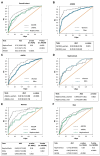Performances of acute kidney injury biomarkers vary according to sex
- PMID: 38699482
- PMCID: PMC11062024
- DOI: 10.1093/ckj/sfae091
Performances of acute kidney injury biomarkers vary according to sex
Abstract
Background: Before implementing individualized strategies to treat acute kidney injury (AKI), identifying clusters of patients with divergent pathophysiological mechanisms, diagnosis criteria or outcomes is of the utmost importance. Here we studied sex-related molecular mechanisms in cardiac bypass (CBP) surgery patients developing AKI.
Methods: We compared the characteristics of 1170 patients referred for CBP surgery using multivariate logistic regression and propensity score-based analysis. Performances of the candidate urinary biomarkers at <4 h post-surgery, urinary neutrophil gelatinase-associated lipocalin (uNGAL), [IGFBP7]·[TIMP-2] product (NephroCheck) and a recently developed AKI signature of 204 urinary peptides (AKI204) to predict AKI were compared in both sexes.
Results: Incidence (∼25%) and severity of AKI were similar in men and women, even after adjustment for the usual risk factors of AKI, including baseline estimated glomerular filtration rate, age, diabetes mellitus, length of CBP and red blood cell transfusion. However, at the molecular level, performances of uNGAL, NephroCheck and AKI204 to predict AKI strongly diverged between men and women. In the full cohort, as well as in subgroups of men and women, the multimarker AKI204 signature outperformed uNGAL and NephroCheck and predicted the development of AKI significantly better in women than in men. Analysis of AKI204 at the single-peptide level suggested divergences of AKI mechanisms between sexes due to increased kidney inflammation in women (increased abundance of urinary fragments of osteopontin and uromodulin).
Conclusions: In patients referred for CBP surgery, significant clinical and biological differences between men and women as well as sexual dimorphism of AKI biomarker performances were identified. The urinary peptide signature points to sex-related molecular mechanisms underlying AKI.
Keywords: NGAL; NephroCheck; acute kidney injury; biomarkers; peptidomics; sexual dimorphism.
© The Author(s) 2024. Published by Oxford University Press on behalf of the ERA.
Conflict of interest statement
J.S. and I.A. are employees of Mosaiques Diagnostics
Figures


References
LinkOut - more resources
Full Text Sources
Research Materials
Miscellaneous

